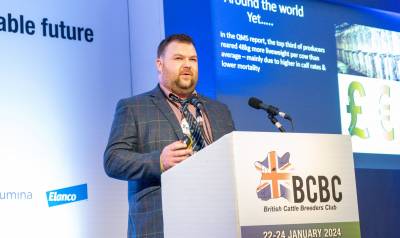
Aberdeenshire suckler farmer Duncan Morrison said running a simple, low-cost grass-based system has helped him build a ‘lean and mean’ business.
Since taking on a 226-acre tenancy in 2016, Mr Morrison and his wife Claire have grown their business to 650 acres and will bull 250 spring-calving cows and heifers this spring – a mix of Aberdeen-Angus and Stabilisers.
He advocated for farmers to become less fixated on beef prices and explained how the UK had one of the highest deadweight prices of £5.03/kg compared to its counterparts (New Zealand: £3/kg; Australia: £1.93kg and USA: £4.99).
“I’m not advocating low beef prices, but it is not the main factor of profitability,” he told delegates.
He said there was huge scope for improvements with QMS data showing the average calving period was 15 weeks.
Mr Morrison runs a low-input, grass-based system and finishes cattle and sells breeding stock.
Building a profitable business
He says having the right genetics for his system has been integral. To find this, he has implemented a strict culling policy backed by data.
Cows are weighed regularly to eliminate those less productive ones. Last season, cows weighed 656kg on average and weaned 41% of their bodyweight but the target is to raise this to 50%.
In the spring and summer, cows and calves rotationally graze herbal leys and are outwintered on deferred grass or kale during the winter.
He expects animals to calve outdoors unassisted following two cycles with the bull. Last season, 77.5% of calves were born in the first cycle.
Cows and heifers calve in one mob from mid-April to reduce labour. Cows are fed bales at night at grass to facilitate daytime calving.
He is running 160 cows/labour unit by selecting easy-calving, docile genetics and ensuring cows have good mothering ability and good teat and udder scores.
“I want cows that can stand up and be counted. A simple system with low fixed costs can be an attainable target for most farms,” he told delegates.
Duncan’s tips for building a profitable suckler enterprise included:
- Base your system on the back of what your farm can achieve.
- Set clear aims and objectives and work out a plan to achieve them.
- Invest in flesh not metal – move away from a heavy mechanised system to create a ‘lean and mean’ business. Mr Morrison’s business owns ‘grass, cows and quad bikes.’
- Build the system first, then breed cows to suit the system. Cows spend 125 days on bale grazing/deferred grass and, to find resilient replacements that can survive tough winters, heifer calves are kept in the same system ‘to filter out genetics that does not work before they cost money’.
- Remove unnecessary processes like de-horning and foot-trimming by using polled bulls and culling for foot misdemeanours.
- Performance record ‘under pressure’ to select which animals to keep. Mr Morrison records frame score, BCS, and mature weight at weaning, for example.
Mr Morrison was speaking at the British Cattle Breeders Conference in January